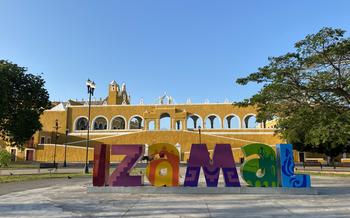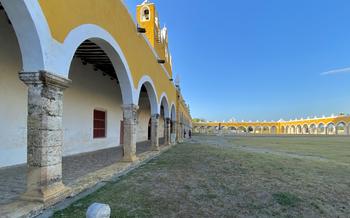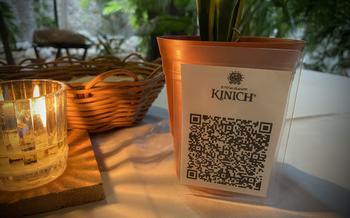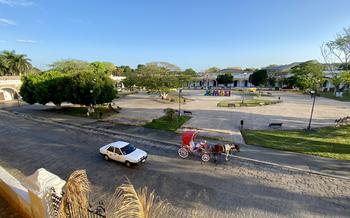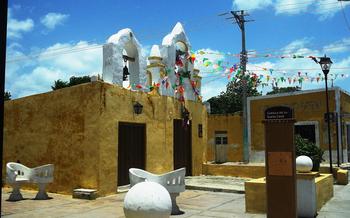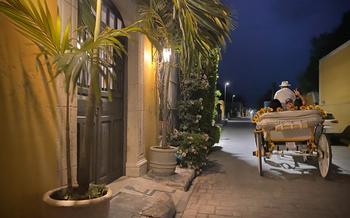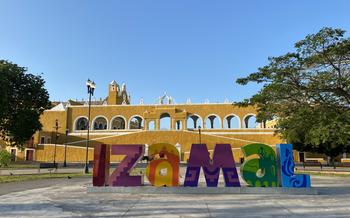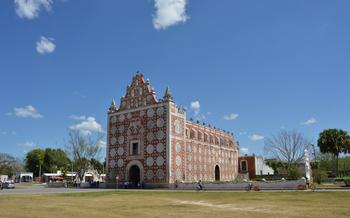
Cenote Kikil (Nearby city)
- Izamal: City of Convents and Cenotes
- Exploring the Cenote
- Swimming and Snorkeling
- Other Activities
- Planning Your Visit
- Safety Tips
- Photography Tips
- History and Culture
- Architecture and Landmarks
- Museums and Galleries
- Festivals and Events
- Local Cuisine
Izamal: City of Convents and Cenotes
Izamal is a charming city located in the Yucatán Peninsula, Mexico. It is known for its colonial architecture, vibrant culture, and proximity to several cenotes, including the stunning Cenote Kikil. With its rich history, friendly locals, and abundance of things to see and do, Izamal is a must-visit destination for anyone traveling to the Yucatán.
Location and Access Izamal is located about 70 kilometers east of Mérida, the capital of Yucatán. It is easily accessible by car or bus, and there are several tour operators that offer day trips from Mérida and other nearby cities.
Things to Do In addition to visiting the cenotes, there are several other things to see and do in Izamal. Visitors can explore the city's many colonial buildings, including the Convent of San Antonio de Padua, the Atrium of San Antonio de Padua, and the Church of Santa María de la Asunción. They can also visit the Museo de Arqueología de Izamal, which houses a collection of Mayan artifacts, or stroll through the Plaza de la Constitución, the city's main square.
Where to Stay and Eat There are several hotels and restaurants in Izamal, ranging from budget-friendly options to luxury resorts. Visitors can find traditional Yucatecan cuisine at many of the city's restaurants, as well as international fare.
Exploring the Cenote
The Cenote Kikil is a natural wonder of unparalleled beauty. The cenote's crystal-clear waters reveal a vibrant underwater world, with lush vegetation and colorful fish darting in and out of the shadows. The cenote's walls are adorned with stalactites and stalagmites, creating a surreal and otherworldly atmosphere.
The cenote has several different levels, each with its own unique charm. The upper level is the most popular for swimming and snorkeling, as it is shallow and has easy access. The lower levels are deeper and darker, and are home to a variety of underwater caves and tunnels. These caves and tunnels are perfect for exploring, and offer a glimpse into the cenote's hidden depths.
The cenote is also home to a variety of wildlife, including turtles, fish, and bats. These animals are an integral part of the cenote's ecosystem, and help to maintain its delicate balance. Visitors to the cenote should be respectful of the wildlife, and avoid disturbing them.
Swimming and Snorkeling
The crystal-clear water of Cenote Kikil is perfect for swimming and snorkeling. The water is so clear that you can see all the way to the bottom, and the colorful fish and other marine life are easy to spot. The visibility is excellent, making it a great place to take underwater photos.
There are several different spots around the cenote that are good for swimming and snorkeling. The shallow areas near the edge of the cenote are perfect for beginners, while the deeper areas further out are better for experienced swimmers and snorkelers.
If you are new to snorkeling, there are several tour operators in Izamal that offer guided snorkeling tours. These tours will provide you with all the necessary equipment and instruction, and they will take you to the best spots for snorkeling in the cenote.
Whether you are a beginner or an experienced swimmer or snorkeler, Cenote Kikil is a great place to enjoy the water and explore the underwater world.
Other Activities
In addition to swimming, snorkeling, and diving, Cenote Kikil and its surroundings offer a variety of other activities for visitors to enjoy. For those seeking a more leisurely experience, kayaking and paddleboarding are excellent ways to explore the cenote's calm waters and admire the surrounding jungle scenery. For those who prefer to stay on land, hiking and biking trails wind through the surrounding jungle, offering opportunities for wildlife spotting and adventure.
History buffs can explore the nearby Mayan ruins of Izamal, which offer a glimpse into the region's rich cultural heritage. And for those looking for a unique souvenir, the city of Izamal offers a variety of shops selling handmade crafts and other local products.
Planning Your Visit
When is the best time to visit Cenote Kikil?
The best time to visit Cenote Kikil is during the dry season, which runs from November to April. During this time, the weather is sunny and dry, and the water in the cenote is at its clearest. The rainy season, which runs from May to October, can bring heavy rains and flooding, which can make it difficult to access the cenote.
What should you bring with you?
When visiting Cenote Kikil, be sure to bring a swimsuit, towel, sunscreen, and insect repellent. You may also want to bring a camera, snorkel gear, and a flashlight if you plan on exploring the underwater caves.
How do you get to Cenote Kikil?
Cenote Kikil is located about 30 minutes from the city of Izamal. To get there, you can take a taxi or rent a car. If you are driving, follow the signs to the cenote, which is located on the road to the town of X-Kalakoop.
How much does it cost to visit Cenote Kikil?
The entrance fee to Cenote Kikil is 150 pesos for adults and 75 pesos for children. The price includes access to the cenote, as well as the use of life jackets and snorkel gear.
Safety Tips
Cenote Kikil is a safe place to visit, but there are a few things to keep in mind to ensure your safety.
- Be aware of the depth of the water. The cenote is very deep in some places, so it is important to be careful when swimming or snorkeling.
- Be careful of the slippery rocks. The rocks around the cenote can be slippery, so it is important to wear shoes with good traction.
- Do not swim or snorkel alone. It is always a good idea to swim or snorkel with a buddy, in case of an emergency.
- Be aware of the local wildlife. There are a variety of animals that live in the cenote, including crocodiles, snakes, and bats. It is important to be aware of these animals and to take precautions to avoid them.
- Do not touch or feed the animals. The animals in the cenote are wild animals and should not be touched or fed.
- Do not leave valuables unattended. The cenote is a popular tourist destination, so it is important to be aware of your surroundings and to keep your valuables safe.
Photography Tips
Capture the beauty of the cenote with stunning photographs.
-
Waterproof camera or housing: The cenote is a wet environment, so a waterproof camera or housing is essential to protect your equipment.
-
Wide-angle lens: A wide-angle lens will allow you to capture the vastness of the cenote and the surrounding jungle.
-
Shoot in RAW format: RAW format gives you more flexibility when editing your photos, allowing you to adjust the white balance, exposure, and other settings.
-
Tripod for long exposures: A tripod will help you stabilize your camera for long exposures, which can capture the stunning underwater world of the cenote.
History and Culture
Izamal has a rich history and culture, dating back to the ancient Maya civilization. The city was once a major center of the Maya world, and its ruins are still visible today. In the 16th century, the Spanish conquistadors arrived in Izamal and built a number of churches and convents on the ruins of the Maya temples. The city's colonial architecture is a reminder of its Spanish past, and its many churches and convents are still used for religious services today.
Izamal is also home to a number of museums and galleries, which showcase the city's history and culture. The Museo de Arqueología de Izamal has a collection of Maya artifacts, while the Museo de la Ciudad de Izamal tells the story of the city's history. The Galería de Arte Contemporáneo de Izamal features works of art by local and international artists.
Architecture and Landmarks
Izamal is known for its well-preserved colonial architecture and historical landmarks. The city's most iconic landmark is the Convent of San Antonio de Padua, a massive Franciscan monastery that dates back to the 16th century. The convent is adorned with intricate carvings and sculptures, and its interior is home to a beautiful altarpiece.
Another must-see landmark in Izamal is the Atrium of San Antonio de Padua, which is located next to the convent. The atrium is one of the largest in the world, and it is surrounded by a series of arched walkways that are lined with shops and restaurants.
The Church of Santa María de la Asunción is another important religious landmark in Izamal. The church was built in the 16th century, and it is home to a number of valuable works of art, including a statue of the Virgin Mary that is said to have been brought to Izamal from Spain.
The Plaza de la Constitución is the main square in Izamal. The square is surrounded by a number of colonial buildings, including the Palacio Municipal (Town Hall) and the Casa de la Cultura (Cultural Center). The Plaza de la Constitución is a popular gathering place for locals and tourists alike, and it is often the site of festivals and events.
Museums and Galleries
Izamal offers a variety of museums and galleries that provide a glimpse into the city's rich history and culture. The Museo de Arqueología de Izamal houses a collection of artifacts from the ancient Maya city, including ceramics, sculptures, and jewelry. The Museo de la Ciudad de Izamal tells the story of the city's founding and development, from its pre-Columbian origins to the present day. The Galería de Arte Contemporáneo de Izamal showcases the work of local and regional artists, with exhibitions that rotate on a regular basis.
These museums and galleries offer a great opportunity to learn more about Izamal's past and present, and to appreciate the city's vibrant arts scene. Whether you're interested in history, archaeology, or art, you're sure to find something to enjoy in Izamal's museums and galleries.
Festivals and Events
Izamal hosts several festivals and events throughout the year, offering a vibrant glimpse into the city's culture and traditions. One of the most famous is the Carnaval de Izamal, held annually in February or March. This colorful and lively celebration features parades, music, dancing, and traditional costumes. The Fiesta de San Antonio de Padua, held on June 13th, honors the city's patron saint with processions, masses, and traditional dances. Another important event is the Fiesta de Santa María de la Asunción, held on August 15th, which celebrates the Assumption of the Virgin Mary with processions, masses, and fireworks. These festivals are a wonderful opportunity to experience Izamal's rich cultural heritage and immerse yourself in the local traditions.
Local Cuisine
Izamal is known for its delicious Yucatecan cuisine, which is a blend of Maya and Spanish influences. Some of the must-try dishes include cochinita pibil, a slow-roasted pork dish cooked in achiote sauce; panuchos, fried tortillas topped with black beans, turkey or chicken, and pickled onions; and salbutes, which are similar to panuchos but with a thicker tortilla.
For a taste of traditional Yucatecan cuisine, head to one of the many family-owned restaurants in Izamal. La Casona del Pollo is a local favorite, serving up delicious cochinita pibil, panuchos, and salbutes. For a more upscale dining experience, try the restaurant at the Hotel Hacienda Izamal, which offers a variety of regional dishes made with fresh, local ingredients.
